Leadership Theories and Practices: A Comparative Analysis of Airlines
VerifiedAdded on 2023/01/12
|16
|5697
|78
Report
AI Summary
This report provides a comparative analysis of the leadership styles and theories employed by Virgin Atlantic and Monarch Airlines. It begins with executive summaries and introductions, followed by an overview of both airlines, highlighting their operational contexts and leadership approaches. The report delves into specific leadership themes, examining how Virgin Atlantic leveraged various theories like Maslow's Hierarchy of Needs, Hofstede's cultural dimensions, and transformational and contingency leadership to foster employee motivation and achieve organizational goals. In contrast, the report explores the leadership failures of Monarch Airlines, attributing its downfall to rigid management structures and ineffective leadership styles. The analysis includes detailed explanations of the theories and models applied, along with their implications for organizational outcomes, ultimately leading to recommendations for improving management practices, emphasizing customer service, and employee training and development to enhance profitability and achieve desired objectives. The report concludes with a summary of findings and a list of references.
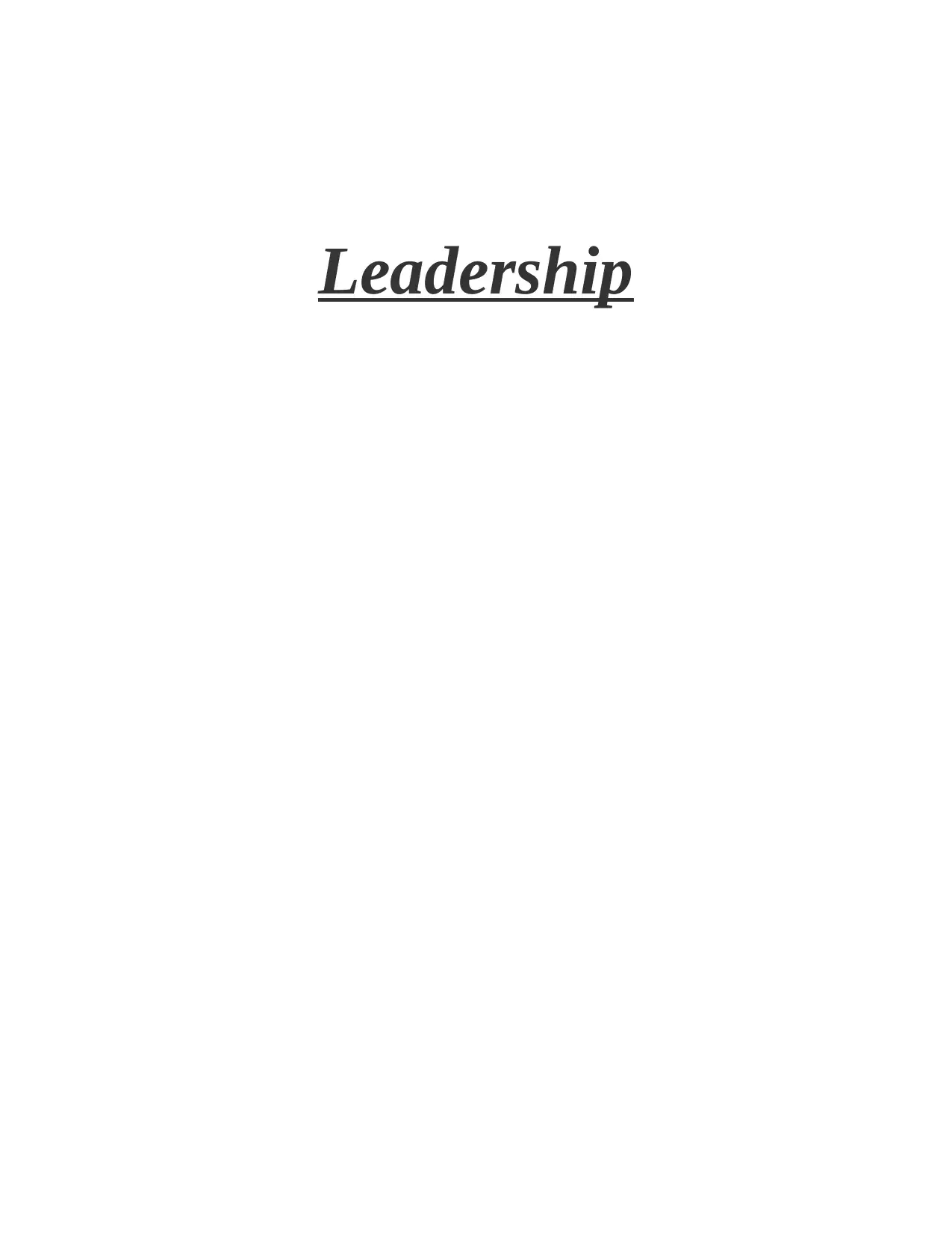
Leadership
Paraphrase This Document
Need a fresh take? Get an instant paraphrase of this document with our AI Paraphraser
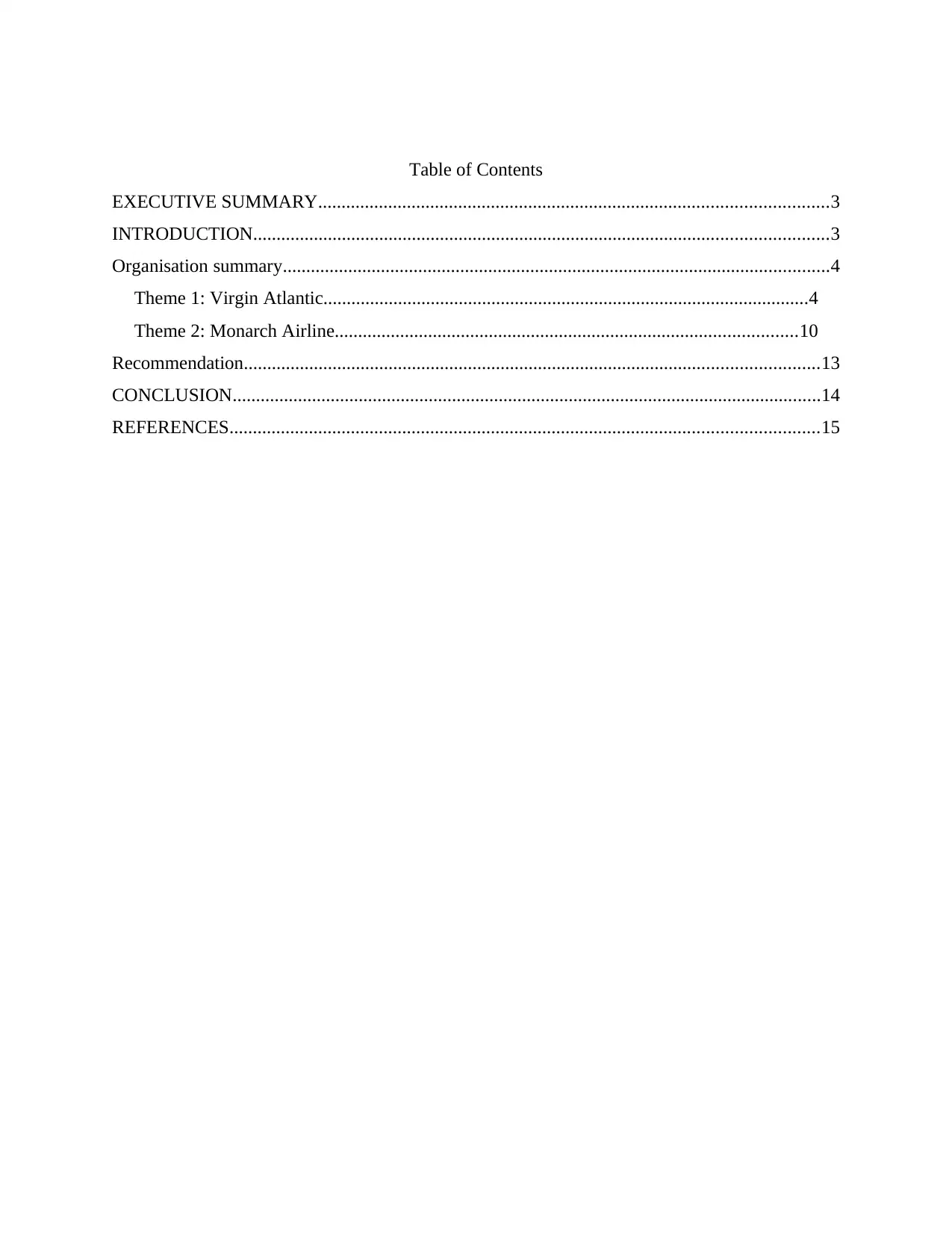
Table of Contents
EXECUTIVE SUMMARY.............................................................................................................3
INTRODUCTION...........................................................................................................................3
Organisation summary.....................................................................................................................4
Theme 1: Virgin Atlantic........................................................................................................4
Theme 2: Monarch Airline...................................................................................................10
Recommendation...........................................................................................................................13
CONCLUSION..............................................................................................................................14
REFERENCES..............................................................................................................................15
EXECUTIVE SUMMARY.............................................................................................................3
INTRODUCTION...........................................................................................................................3
Organisation summary.....................................................................................................................4
Theme 1: Virgin Atlantic........................................................................................................4
Theme 2: Monarch Airline...................................................................................................10
Recommendation...........................................................................................................................13
CONCLUSION..............................................................................................................................14
REFERENCES..............................................................................................................................15
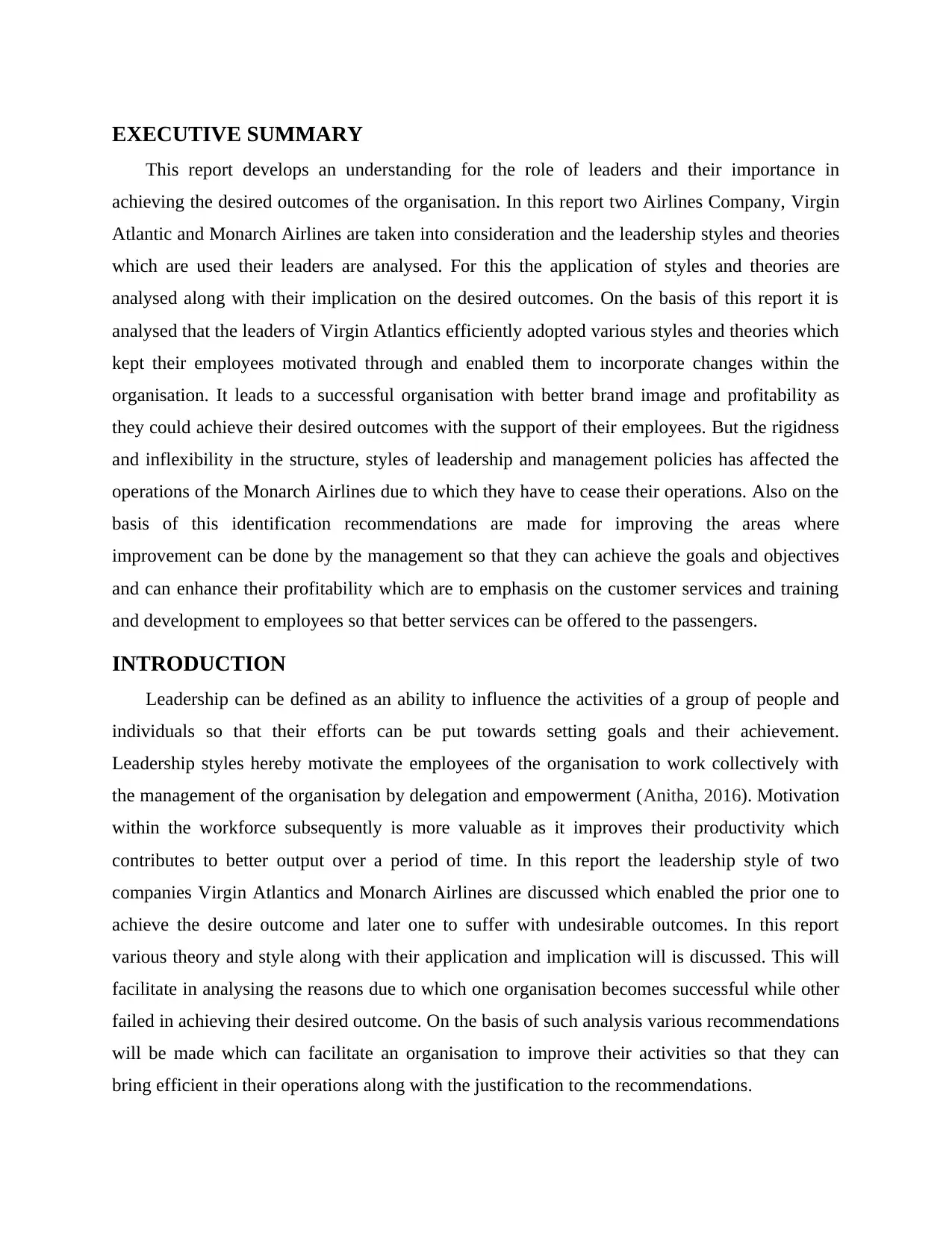
EXECUTIVE SUMMARY
This report develops an understanding for the role of leaders and their importance in
achieving the desired outcomes of the organisation. In this report two Airlines Company, Virgin
Atlantic and Monarch Airlines are taken into consideration and the leadership styles and theories
which are used their leaders are analysed. For this the application of styles and theories are
analysed along with their implication on the desired outcomes. On the basis of this report it is
analysed that the leaders of Virgin Atlantics efficiently adopted various styles and theories which
kept their employees motivated through and enabled them to incorporate changes within the
organisation. It leads to a successful organisation with better brand image and profitability as
they could achieve their desired outcomes with the support of their employees. But the rigidness
and inflexibility in the structure, styles of leadership and management policies has affected the
operations of the Monarch Airlines due to which they have to cease their operations. Also on the
basis of this identification recommendations are made for improving the areas where
improvement can be done by the management so that they can achieve the goals and objectives
and can enhance their profitability which are to emphasis on the customer services and training
and development to employees so that better services can be offered to the passengers.
INTRODUCTION
Leadership can be defined as an ability to influence the activities of a group of people and
individuals so that their efforts can be put towards setting goals and their achievement.
Leadership styles hereby motivate the employees of the organisation to work collectively with
the management of the organisation by delegation and empowerment (Anitha, 2016). Motivation
within the workforce subsequently is more valuable as it improves their productivity which
contributes to better output over a period of time. In this report the leadership style of two
companies Virgin Atlantics and Monarch Airlines are discussed which enabled the prior one to
achieve the desire outcome and later one to suffer with undesirable outcomes. In this report
various theory and style along with their application and implication will is discussed. This will
facilitate in analysing the reasons due to which one organisation becomes successful while other
failed in achieving their desired outcome. On the basis of such analysis various recommendations
will be made which can facilitate an organisation to improve their activities so that they can
bring efficient in their operations along with the justification to the recommendations.
This report develops an understanding for the role of leaders and their importance in
achieving the desired outcomes of the organisation. In this report two Airlines Company, Virgin
Atlantic and Monarch Airlines are taken into consideration and the leadership styles and theories
which are used their leaders are analysed. For this the application of styles and theories are
analysed along with their implication on the desired outcomes. On the basis of this report it is
analysed that the leaders of Virgin Atlantics efficiently adopted various styles and theories which
kept their employees motivated through and enabled them to incorporate changes within the
organisation. It leads to a successful organisation with better brand image and profitability as
they could achieve their desired outcomes with the support of their employees. But the rigidness
and inflexibility in the structure, styles of leadership and management policies has affected the
operations of the Monarch Airlines due to which they have to cease their operations. Also on the
basis of this identification recommendations are made for improving the areas where
improvement can be done by the management so that they can achieve the goals and objectives
and can enhance their profitability which are to emphasis on the customer services and training
and development to employees so that better services can be offered to the passengers.
INTRODUCTION
Leadership can be defined as an ability to influence the activities of a group of people and
individuals so that their efforts can be put towards setting goals and their achievement.
Leadership styles hereby motivate the employees of the organisation to work collectively with
the management of the organisation by delegation and empowerment (Anitha, 2016). Motivation
within the workforce subsequently is more valuable as it improves their productivity which
contributes to better output over a period of time. In this report the leadership style of two
companies Virgin Atlantics and Monarch Airlines are discussed which enabled the prior one to
achieve the desire outcome and later one to suffer with undesirable outcomes. In this report
various theory and style along with their application and implication will is discussed. This will
facilitate in analysing the reasons due to which one organisation becomes successful while other
failed in achieving their desired outcome. On the basis of such analysis various recommendations
will be made which can facilitate an organisation to improve their activities so that they can
bring efficient in their operations along with the justification to the recommendations.
⊘ This is a preview!⊘
Do you want full access?
Subscribe today to unlock all pages.

Trusted by 1+ million students worldwide
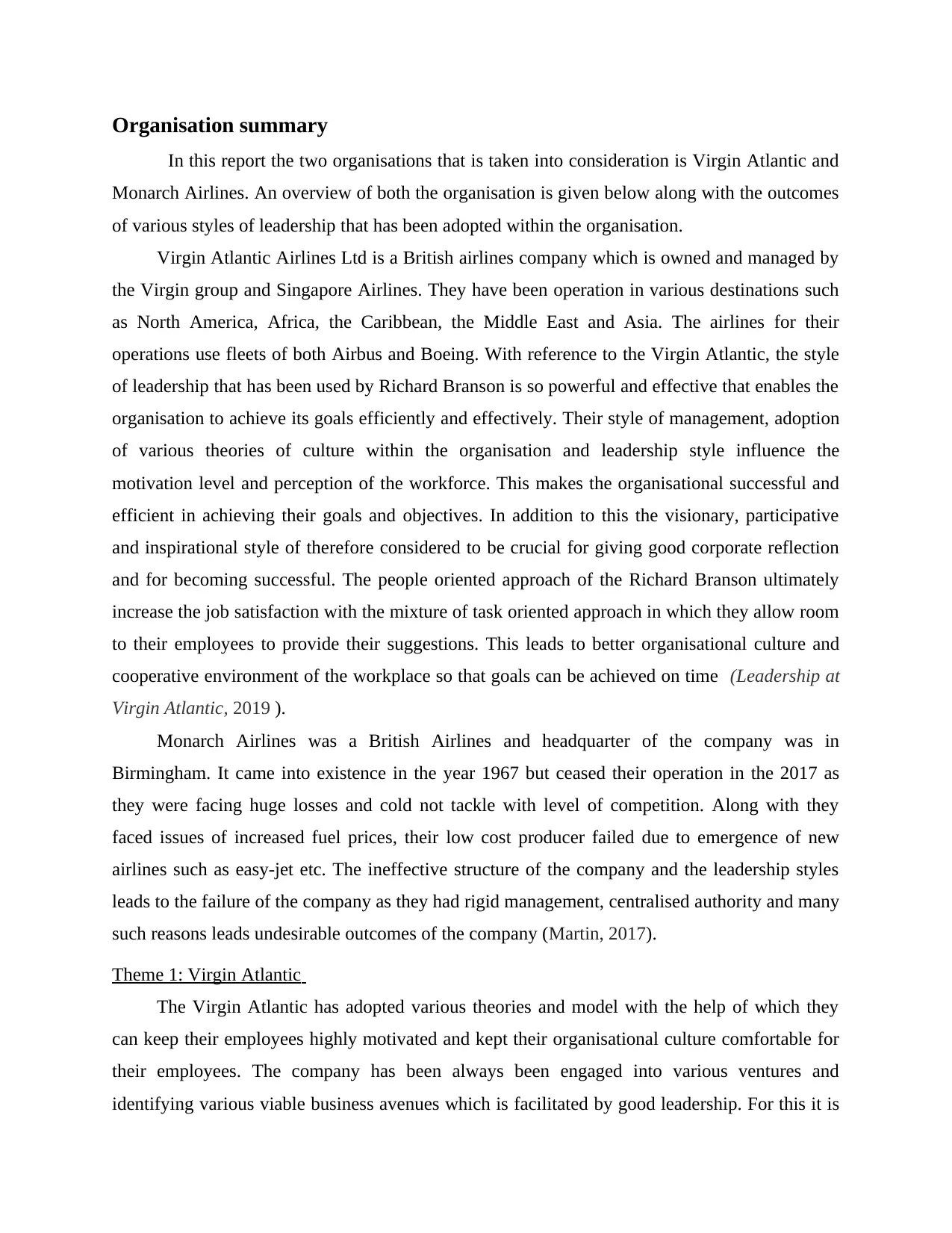
Organisation summary
In this report the two organisations that is taken into consideration is Virgin Atlantic and
Monarch Airlines. An overview of both the organisation is given below along with the outcomes
of various styles of leadership that has been adopted within the organisation.
Virgin Atlantic Airlines Ltd is a British airlines company which is owned and managed by
the Virgin group and Singapore Airlines. They have been operation in various destinations such
as North America, Africa, the Caribbean, the Middle East and Asia. The airlines for their
operations use fleets of both Airbus and Boeing. With reference to the Virgin Atlantic, the style
of leadership that has been used by Richard Branson is so powerful and effective that enables the
organisation to achieve its goals efficiently and effectively. Their style of management, adoption
of various theories of culture within the organisation and leadership style influence the
motivation level and perception of the workforce. This makes the organisational successful and
efficient in achieving their goals and objectives. In addition to this the visionary, participative
and inspirational style of therefore considered to be crucial for giving good corporate reflection
and for becoming successful. The people oriented approach of the Richard Branson ultimately
increase the job satisfaction with the mixture of task oriented approach in which they allow room
to their employees to provide their suggestions. This leads to better organisational culture and
cooperative environment of the workplace so that goals can be achieved on time (Leadership at
Virgin Atlantic, 2019 ).
Monarch Airlines was a British Airlines and headquarter of the company was in
Birmingham. It came into existence in the year 1967 but ceased their operation in the 2017 as
they were facing huge losses and cold not tackle with level of competition. Along with they
faced issues of increased fuel prices, their low cost producer failed due to emergence of new
airlines such as easy-jet etc. The ineffective structure of the company and the leadership styles
leads to the failure of the company as they had rigid management, centralised authority and many
such reasons leads undesirable outcomes of the company (Martin, 2017).
Theme 1: Virgin Atlantic
The Virgin Atlantic has adopted various theories and model with the help of which they
can keep their employees highly motivated and kept their organisational culture comfortable for
their employees. The company has been always been engaged into various ventures and
identifying various viable business avenues which is facilitated by good leadership. For this it is
In this report the two organisations that is taken into consideration is Virgin Atlantic and
Monarch Airlines. An overview of both the organisation is given below along with the outcomes
of various styles of leadership that has been adopted within the organisation.
Virgin Atlantic Airlines Ltd is a British airlines company which is owned and managed by
the Virgin group and Singapore Airlines. They have been operation in various destinations such
as North America, Africa, the Caribbean, the Middle East and Asia. The airlines for their
operations use fleets of both Airbus and Boeing. With reference to the Virgin Atlantic, the style
of leadership that has been used by Richard Branson is so powerful and effective that enables the
organisation to achieve its goals efficiently and effectively. Their style of management, adoption
of various theories of culture within the organisation and leadership style influence the
motivation level and perception of the workforce. This makes the organisational successful and
efficient in achieving their goals and objectives. In addition to this the visionary, participative
and inspirational style of therefore considered to be crucial for giving good corporate reflection
and for becoming successful. The people oriented approach of the Richard Branson ultimately
increase the job satisfaction with the mixture of task oriented approach in which they allow room
to their employees to provide their suggestions. This leads to better organisational culture and
cooperative environment of the workplace so that goals can be achieved on time (Leadership at
Virgin Atlantic, 2019 ).
Monarch Airlines was a British Airlines and headquarter of the company was in
Birmingham. It came into existence in the year 1967 but ceased their operation in the 2017 as
they were facing huge losses and cold not tackle with level of competition. Along with they
faced issues of increased fuel prices, their low cost producer failed due to emergence of new
airlines such as easy-jet etc. The ineffective structure of the company and the leadership styles
leads to the failure of the company as they had rigid management, centralised authority and many
such reasons leads undesirable outcomes of the company (Martin, 2017).
Theme 1: Virgin Atlantic
The Virgin Atlantic has adopted various theories and model with the help of which they
can keep their employees highly motivated and kept their organisational culture comfortable for
their employees. The company has been always been engaged into various ventures and
identifying various viable business avenues which is facilitated by good leadership. For this it is
Paraphrase This Document
Need a fresh take? Get an instant paraphrase of this document with our AI Paraphraser
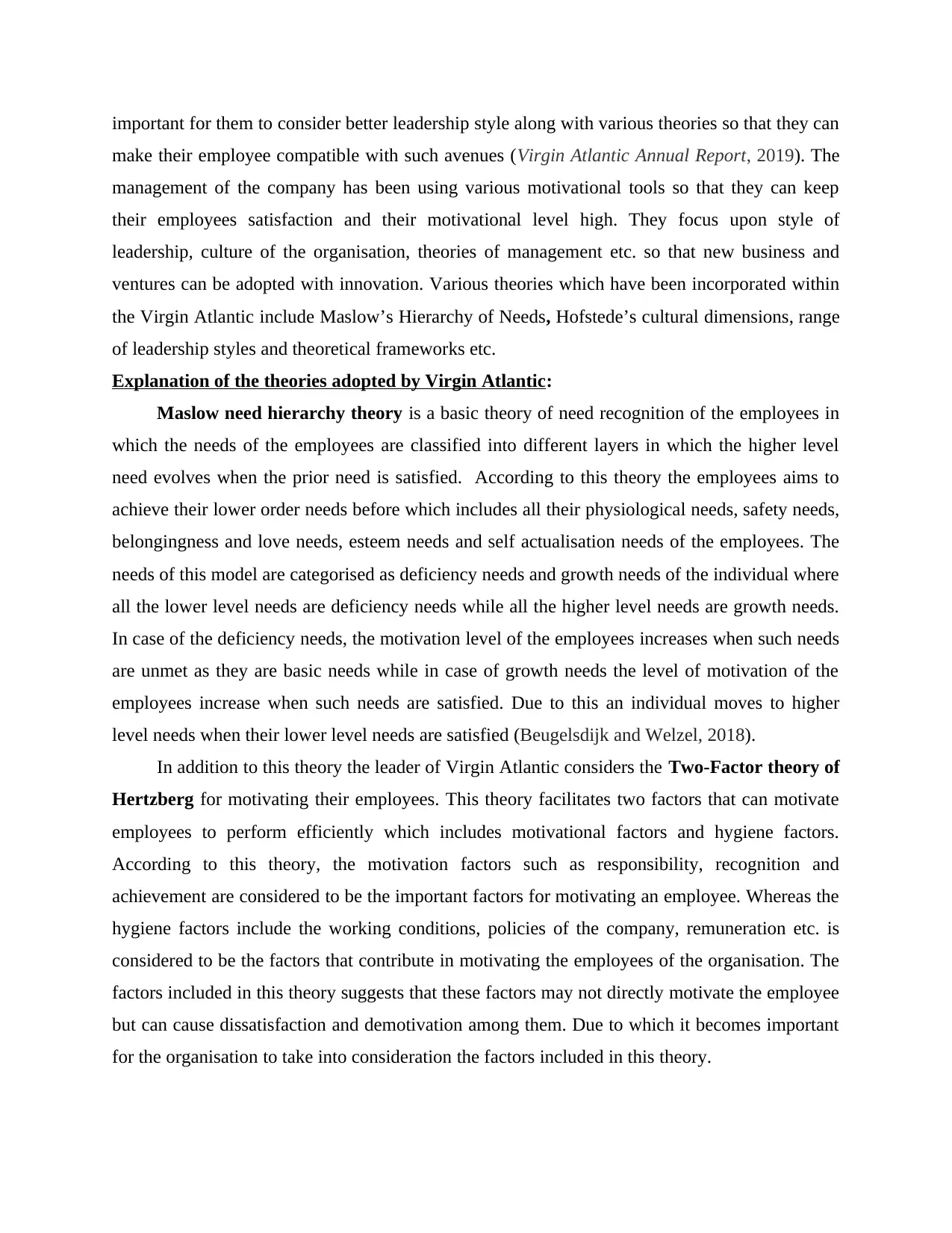
important for them to consider better leadership style along with various theories so that they can
make their employee compatible with such avenues (Virgin Atlantic Annual Report, 2019). The
management of the company has been using various motivational tools so that they can keep
their employees satisfaction and their motivational level high. They focus upon style of
leadership, culture of the organisation, theories of management etc. so that new business and
ventures can be adopted with innovation. Various theories which have been incorporated within
the Virgin Atlantic include Maslow’s Hierarchy of Needs, Hofstede’s cultural dimensions, range
of leadership styles and theoretical frameworks etc.
Explanation of the theories adopted by Virgin Atlantic:
Maslow need hierarchy theory is a basic theory of need recognition of the employees in
which the needs of the employees are classified into different layers in which the higher level
need evolves when the prior need is satisfied. According to this theory the employees aims to
achieve their lower order needs before which includes all their physiological needs, safety needs,
belongingness and love needs, esteem needs and self actualisation needs of the employees. The
needs of this model are categorised as deficiency needs and growth needs of the individual where
all the lower level needs are deficiency needs while all the higher level needs are growth needs.
In case of the deficiency needs, the motivation level of the employees increases when such needs
are unmet as they are basic needs while in case of growth needs the level of motivation of the
employees increase when such needs are satisfied. Due to this an individual moves to higher
level needs when their lower level needs are satisfied (Beugelsdijk and Welzel, 2018).
In addition to this theory the leader of Virgin Atlantic considers the Two-Factor theory of
Hertzberg for motivating their employees. This theory facilitates two factors that can motivate
employees to perform efficiently which includes motivational factors and hygiene factors.
According to this theory, the motivation factors such as responsibility, recognition and
achievement are considered to be the important factors for motivating an employee. Whereas the
hygiene factors include the working conditions, policies of the company, remuneration etc. is
considered to be the factors that contribute in motivating the employees of the organisation. The
factors included in this theory suggests that these factors may not directly motivate the employee
but can cause dissatisfaction and demotivation among them. Due to which it becomes important
for the organisation to take into consideration the factors included in this theory.
make their employee compatible with such avenues (Virgin Atlantic Annual Report, 2019). The
management of the company has been using various motivational tools so that they can keep
their employees satisfaction and their motivational level high. They focus upon style of
leadership, culture of the organisation, theories of management etc. so that new business and
ventures can be adopted with innovation. Various theories which have been incorporated within
the Virgin Atlantic include Maslow’s Hierarchy of Needs, Hofstede’s cultural dimensions, range
of leadership styles and theoretical frameworks etc.
Explanation of the theories adopted by Virgin Atlantic:
Maslow need hierarchy theory is a basic theory of need recognition of the employees in
which the needs of the employees are classified into different layers in which the higher level
need evolves when the prior need is satisfied. According to this theory the employees aims to
achieve their lower order needs before which includes all their physiological needs, safety needs,
belongingness and love needs, esteem needs and self actualisation needs of the employees. The
needs of this model are categorised as deficiency needs and growth needs of the individual where
all the lower level needs are deficiency needs while all the higher level needs are growth needs.
In case of the deficiency needs, the motivation level of the employees increases when such needs
are unmet as they are basic needs while in case of growth needs the level of motivation of the
employees increase when such needs are satisfied. Due to this an individual moves to higher
level needs when their lower level needs are satisfied (Beugelsdijk and Welzel, 2018).
In addition to this theory the leader of Virgin Atlantic considers the Two-Factor theory of
Hertzberg for motivating their employees. This theory facilitates two factors that can motivate
employees to perform efficiently which includes motivational factors and hygiene factors.
According to this theory, the motivation factors such as responsibility, recognition and
achievement are considered to be the important factors for motivating an employee. Whereas the
hygiene factors include the working conditions, policies of the company, remuneration etc. is
considered to be the factors that contribute in motivating the employees of the organisation. The
factors included in this theory suggests that these factors may not directly motivate the employee
but can cause dissatisfaction and demotivation among them. Due to which it becomes important
for the organisation to take into consideration the factors included in this theory.
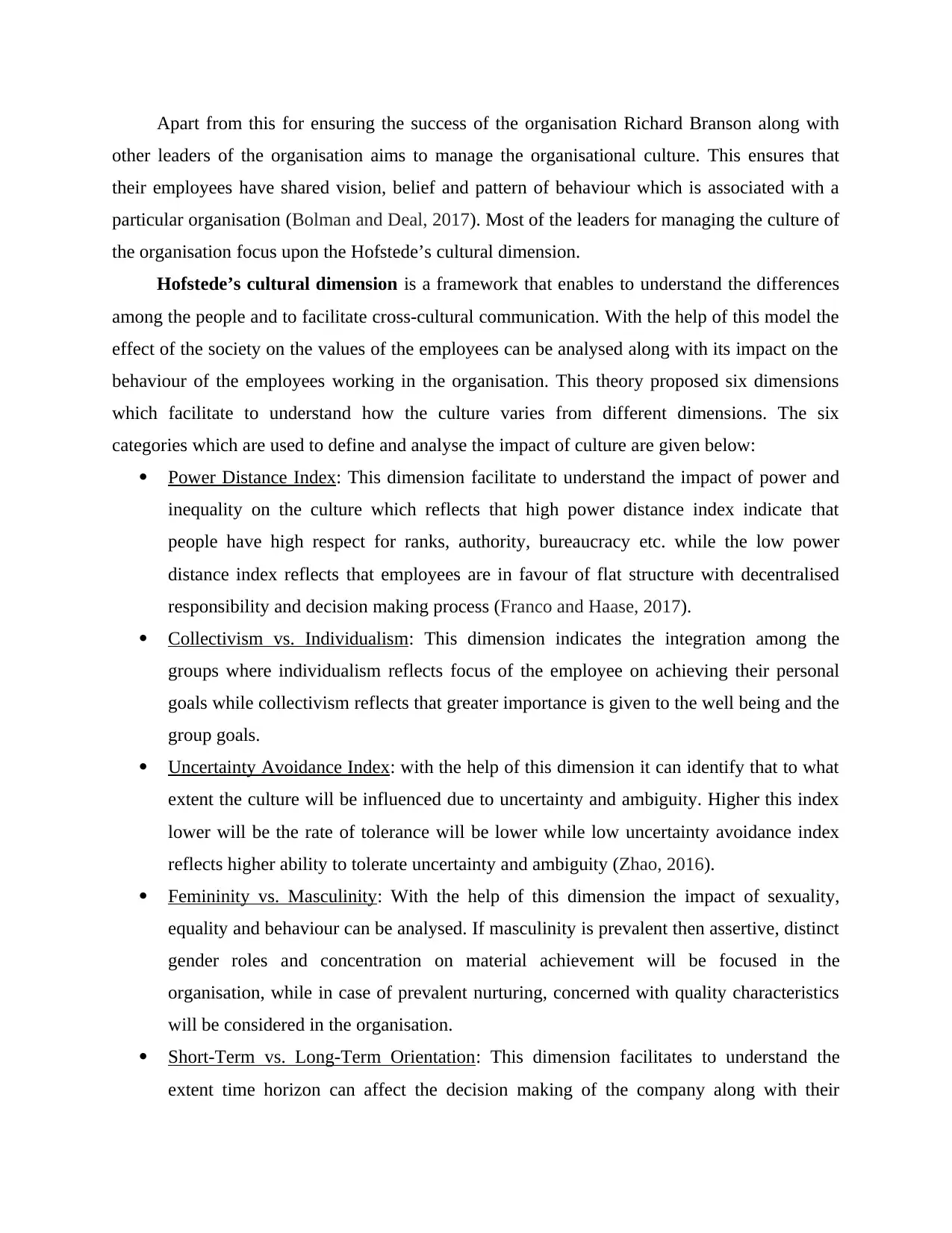
Apart from this for ensuring the success of the organisation Richard Branson along with
other leaders of the organisation aims to manage the organisational culture. This ensures that
their employees have shared vision, belief and pattern of behaviour which is associated with a
particular organisation (Bolman and Deal, 2017). Most of the leaders for managing the culture of
the organisation focus upon the Hofstede’s cultural dimension.
Hofstede’s cultural dimension is a framework that enables to understand the differences
among the people and to facilitate cross-cultural communication. With the help of this model the
effect of the society on the values of the employees can be analysed along with its impact on the
behaviour of the employees working in the organisation. This theory proposed six dimensions
which facilitate to understand how the culture varies from different dimensions. The six
categories which are used to define and analyse the impact of culture are given below:
Power Distance Index: This dimension facilitate to understand the impact of power and
inequality on the culture which reflects that high power distance index indicate that
people have high respect for ranks, authority, bureaucracy etc. while the low power
distance index reflects that employees are in favour of flat structure with decentralised
responsibility and decision making process (Franco and Haase, 2017).
Collectivism vs. Individualism: This dimension indicates the integration among the
groups where individualism reflects focus of the employee on achieving their personal
goals while collectivism reflects that greater importance is given to the well being and the
group goals.
Uncertainty Avoidance Index: with the help of this dimension it can identify that to what
extent the culture will be influenced due to uncertainty and ambiguity. Higher this index
lower will be the rate of tolerance will be lower while low uncertainty avoidance index
reflects higher ability to tolerate uncertainty and ambiguity (Zhao, 2016).
Femininity vs. Masculinity: With the help of this dimension the impact of sexuality,
equality and behaviour can be analysed. If masculinity is prevalent then assertive, distinct
gender roles and concentration on material achievement will be focused in the
organisation, while in case of prevalent nurturing, concerned with quality characteristics
will be considered in the organisation.
Short-Term vs. Long-Term Orientation: This dimension facilitates to understand the
extent time horizon can affect the decision making of the company along with their
other leaders of the organisation aims to manage the organisational culture. This ensures that
their employees have shared vision, belief and pattern of behaviour which is associated with a
particular organisation (Bolman and Deal, 2017). Most of the leaders for managing the culture of
the organisation focus upon the Hofstede’s cultural dimension.
Hofstede’s cultural dimension is a framework that enables to understand the differences
among the people and to facilitate cross-cultural communication. With the help of this model the
effect of the society on the values of the employees can be analysed along with its impact on the
behaviour of the employees working in the organisation. This theory proposed six dimensions
which facilitate to understand how the culture varies from different dimensions. The six
categories which are used to define and analyse the impact of culture are given below:
Power Distance Index: This dimension facilitate to understand the impact of power and
inequality on the culture which reflects that high power distance index indicate that
people have high respect for ranks, authority, bureaucracy etc. while the low power
distance index reflects that employees are in favour of flat structure with decentralised
responsibility and decision making process (Franco and Haase, 2017).
Collectivism vs. Individualism: This dimension indicates the integration among the
groups where individualism reflects focus of the employee on achieving their personal
goals while collectivism reflects that greater importance is given to the well being and the
group goals.
Uncertainty Avoidance Index: with the help of this dimension it can identify that to what
extent the culture will be influenced due to uncertainty and ambiguity. Higher this index
lower will be the rate of tolerance will be lower while low uncertainty avoidance index
reflects higher ability to tolerate uncertainty and ambiguity (Zhao, 2016).
Femininity vs. Masculinity: With the help of this dimension the impact of sexuality,
equality and behaviour can be analysed. If masculinity is prevalent then assertive, distinct
gender roles and concentration on material achievement will be focused in the
organisation, while in case of prevalent nurturing, concerned with quality characteristics
will be considered in the organisation.
Short-Term vs. Long-Term Orientation: This dimension facilitates to understand the
extent time horizon can affect the decision making of the company along with their
⊘ This is a preview!⊘
Do you want full access?
Subscribe today to unlock all pages.

Trusted by 1+ million students worldwide
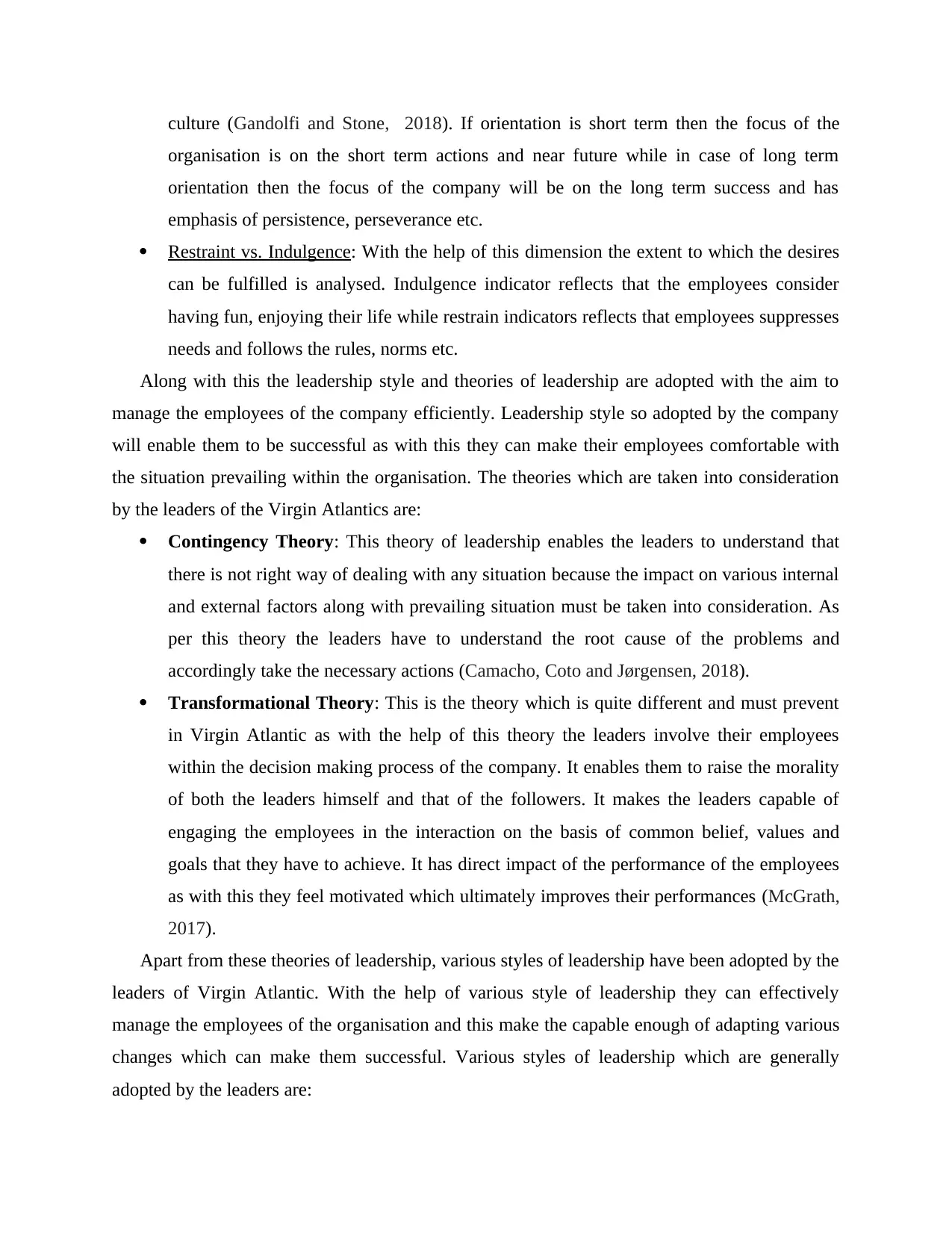
culture (Gandolfi and Stone, 2018). If orientation is short term then the focus of the
organisation is on the short term actions and near future while in case of long term
orientation then the focus of the company will be on the long term success and has
emphasis of persistence, perseverance etc.
Restraint vs. Indulgence: With the help of this dimension the extent to which the desires
can be fulfilled is analysed. Indulgence indicator reflects that the employees consider
having fun, enjoying their life while restrain indicators reflects that employees suppresses
needs and follows the rules, norms etc.
Along with this the leadership style and theories of leadership are adopted with the aim to
manage the employees of the company efficiently. Leadership style so adopted by the company
will enable them to be successful as with this they can make their employees comfortable with
the situation prevailing within the organisation. The theories which are taken into consideration
by the leaders of the Virgin Atlantics are:
Contingency Theory: This theory of leadership enables the leaders to understand that
there is not right way of dealing with any situation because the impact on various internal
and external factors along with prevailing situation must be taken into consideration. As
per this theory the leaders have to understand the root cause of the problems and
accordingly take the necessary actions (Camacho, Coto and Jørgensen, 2018).
Transformational Theory: This is the theory which is quite different and must prevent
in Virgin Atlantic as with the help of this theory the leaders involve their employees
within the decision making process of the company. It enables them to raise the morality
of both the leaders himself and that of the followers. It makes the leaders capable of
engaging the employees in the interaction on the basis of common belief, values and
goals that they have to achieve. It has direct impact of the performance of the employees
as with this they feel motivated which ultimately improves their performances (McGrath,
2017).
Apart from these theories of leadership, various styles of leadership have been adopted by the
leaders of Virgin Atlantic. With the help of various style of leadership they can effectively
manage the employees of the organisation and this make the capable enough of adapting various
changes which can make them successful. Various styles of leadership which are generally
adopted by the leaders are:
organisation is on the short term actions and near future while in case of long term
orientation then the focus of the company will be on the long term success and has
emphasis of persistence, perseverance etc.
Restraint vs. Indulgence: With the help of this dimension the extent to which the desires
can be fulfilled is analysed. Indulgence indicator reflects that the employees consider
having fun, enjoying their life while restrain indicators reflects that employees suppresses
needs and follows the rules, norms etc.
Along with this the leadership style and theories of leadership are adopted with the aim to
manage the employees of the company efficiently. Leadership style so adopted by the company
will enable them to be successful as with this they can make their employees comfortable with
the situation prevailing within the organisation. The theories which are taken into consideration
by the leaders of the Virgin Atlantics are:
Contingency Theory: This theory of leadership enables the leaders to understand that
there is not right way of dealing with any situation because the impact on various internal
and external factors along with prevailing situation must be taken into consideration. As
per this theory the leaders have to understand the root cause of the problems and
accordingly take the necessary actions (Camacho, Coto and Jørgensen, 2018).
Transformational Theory: This is the theory which is quite different and must prevent
in Virgin Atlantic as with the help of this theory the leaders involve their employees
within the decision making process of the company. It enables them to raise the morality
of both the leaders himself and that of the followers. It makes the leaders capable of
engaging the employees in the interaction on the basis of common belief, values and
goals that they have to achieve. It has direct impact of the performance of the employees
as with this they feel motivated which ultimately improves their performances (McGrath,
2017).
Apart from these theories of leadership, various styles of leadership have been adopted by the
leaders of Virgin Atlantic. With the help of various style of leadership they can effectively
manage the employees of the organisation and this make the capable enough of adapting various
changes which can make them successful. Various styles of leadership which are generally
adopted by the leaders are:
Paraphrase This Document
Need a fresh take? Get an instant paraphrase of this document with our AI Paraphraser
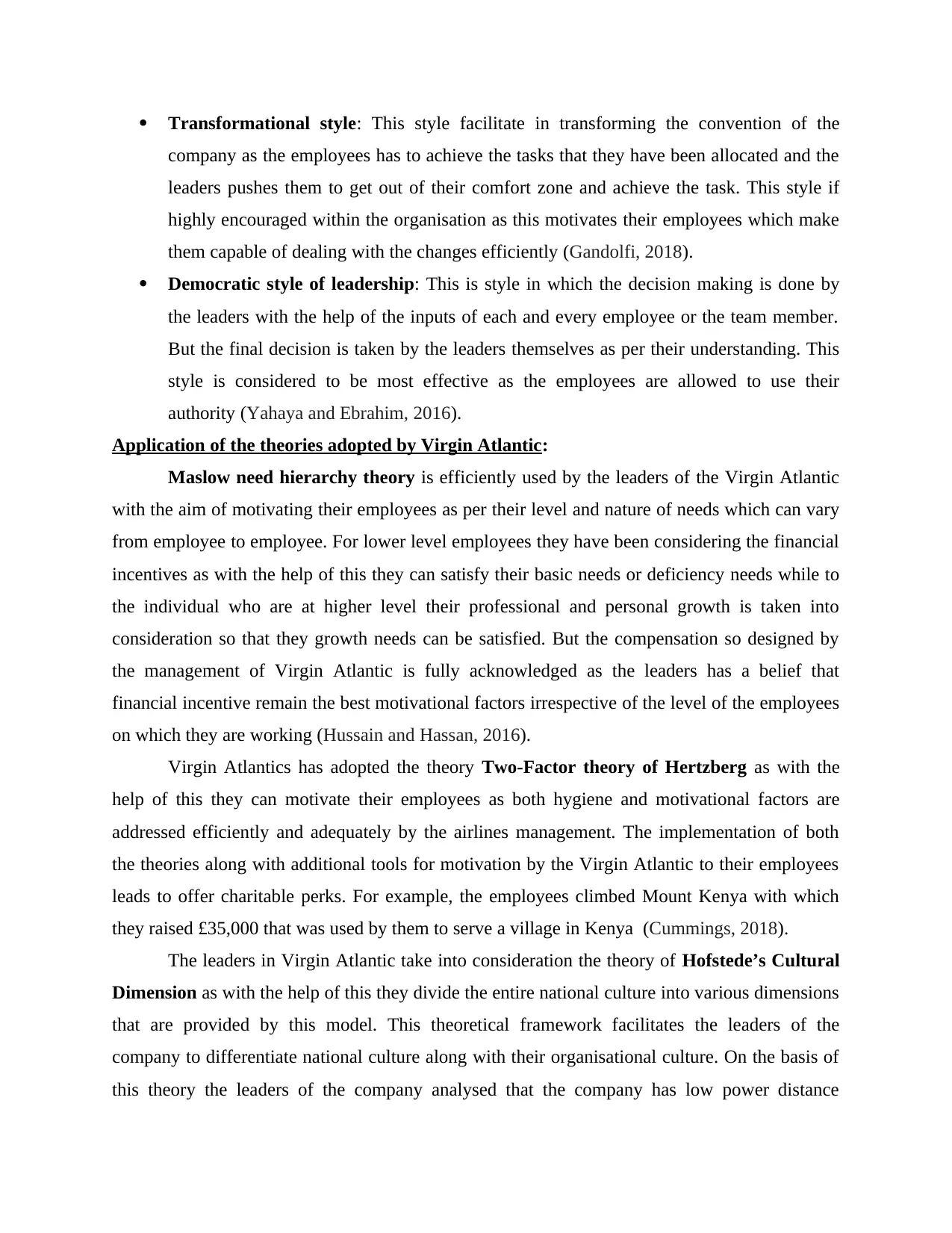
Transformational style: This style facilitate in transforming the convention of the
company as the employees has to achieve the tasks that they have been allocated and the
leaders pushes them to get out of their comfort zone and achieve the task. This style if
highly encouraged within the organisation as this motivates their employees which make
them capable of dealing with the changes efficiently (Gandolfi, 2018).
Democratic style of leadership: This is style in which the decision making is done by
the leaders with the help of the inputs of each and every employee or the team member.
But the final decision is taken by the leaders themselves as per their understanding. This
style is considered to be most effective as the employees are allowed to use their
authority (Yahaya and Ebrahim, 2016).
Application of the theories adopted by Virgin Atlantic:
Maslow need hierarchy theory is efficiently used by the leaders of the Virgin Atlantic
with the aim of motivating their employees as per their level and nature of needs which can vary
from employee to employee. For lower level employees they have been considering the financial
incentives as with the help of this they can satisfy their basic needs or deficiency needs while to
the individual who are at higher level their professional and personal growth is taken into
consideration so that they growth needs can be satisfied. But the compensation so designed by
the management of Virgin Atlantic is fully acknowledged as the leaders has a belief that
financial incentive remain the best motivational factors irrespective of the level of the employees
on which they are working (Hussain and Hassan, 2016).
Virgin Atlantics has adopted the theory Two-Factor theory of Hertzberg as with the
help of this they can motivate their employees as both hygiene and motivational factors are
addressed efficiently and adequately by the airlines management. The implementation of both
the theories along with additional tools for motivation by the Virgin Atlantic to their employees
leads to offer charitable perks. For example, the employees climbed Mount Kenya with which
they raised £35,000 that was used by them to serve a village in Kenya (Cummings, 2018).
The leaders in Virgin Atlantic take into consideration the theory of Hofstede’s Cultural
Dimension as with the help of this they divide the entire national culture into various dimensions
that are provided by this model. This theoretical framework facilitates the leaders of the
company to differentiate national culture along with their organisational culture. On the basis of
this theory the leaders of the company analysed that the company has low power distance
company as the employees has to achieve the tasks that they have been allocated and the
leaders pushes them to get out of their comfort zone and achieve the task. This style if
highly encouraged within the organisation as this motivates their employees which make
them capable of dealing with the changes efficiently (Gandolfi, 2018).
Democratic style of leadership: This is style in which the decision making is done by
the leaders with the help of the inputs of each and every employee or the team member.
But the final decision is taken by the leaders themselves as per their understanding. This
style is considered to be most effective as the employees are allowed to use their
authority (Yahaya and Ebrahim, 2016).
Application of the theories adopted by Virgin Atlantic:
Maslow need hierarchy theory is efficiently used by the leaders of the Virgin Atlantic
with the aim of motivating their employees as per their level and nature of needs which can vary
from employee to employee. For lower level employees they have been considering the financial
incentives as with the help of this they can satisfy their basic needs or deficiency needs while to
the individual who are at higher level their professional and personal growth is taken into
consideration so that they growth needs can be satisfied. But the compensation so designed by
the management of Virgin Atlantic is fully acknowledged as the leaders has a belief that
financial incentive remain the best motivational factors irrespective of the level of the employees
on which they are working (Hussain and Hassan, 2016).
Virgin Atlantics has adopted the theory Two-Factor theory of Hertzberg as with the
help of this they can motivate their employees as both hygiene and motivational factors are
addressed efficiently and adequately by the airlines management. The implementation of both
the theories along with additional tools for motivation by the Virgin Atlantic to their employees
leads to offer charitable perks. For example, the employees climbed Mount Kenya with which
they raised £35,000 that was used by them to serve a village in Kenya (Cummings, 2018).
The leaders in Virgin Atlantic take into consideration the theory of Hofstede’s Cultural
Dimension as with the help of this they divide the entire national culture into various dimensions
that are provided by this model. This theoretical framework facilitates the leaders of the
company to differentiate national culture along with their organisational culture. On the basis of
this theory the leaders of the company analysed that the company has low power distance
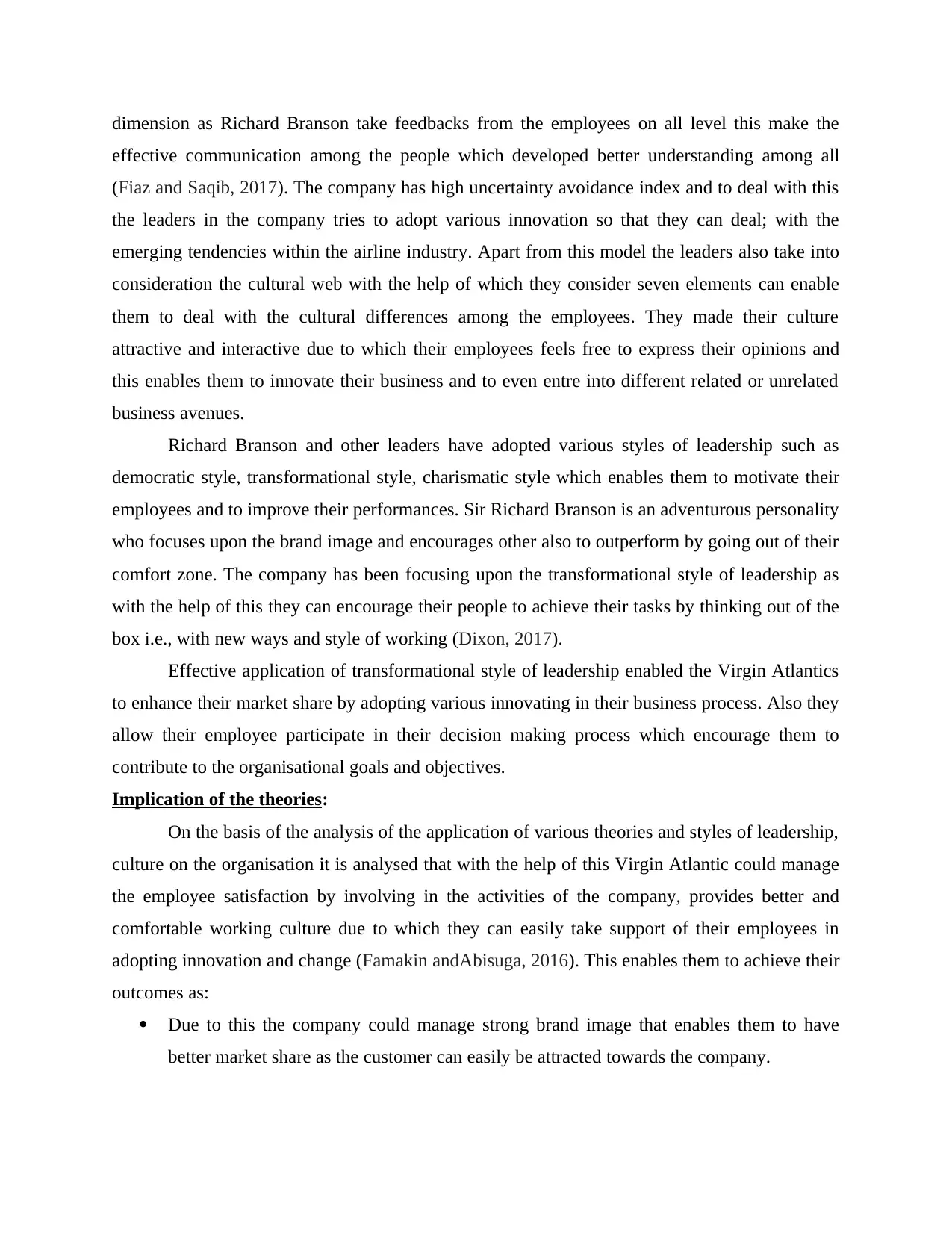
dimension as Richard Branson take feedbacks from the employees on all level this make the
effective communication among the people which developed better understanding among all
(Fiaz and Saqib, 2017). The company has high uncertainty avoidance index and to deal with this
the leaders in the company tries to adopt various innovation so that they can deal; with the
emerging tendencies within the airline industry. Apart from this model the leaders also take into
consideration the cultural web with the help of which they consider seven elements can enable
them to deal with the cultural differences among the employees. They made their culture
attractive and interactive due to which their employees feels free to express their opinions and
this enables them to innovate their business and to even entre into different related or unrelated
business avenues.
Richard Branson and other leaders have adopted various styles of leadership such as
democratic style, transformational style, charismatic style which enables them to motivate their
employees and to improve their performances. Sir Richard Branson is an adventurous personality
who focuses upon the brand image and encourages other also to outperform by going out of their
comfort zone. The company has been focusing upon the transformational style of leadership as
with the help of this they can encourage their people to achieve their tasks by thinking out of the
box i.e., with new ways and style of working (Dixon, 2017).
Effective application of transformational style of leadership enabled the Virgin Atlantics
to enhance their market share by adopting various innovating in their business process. Also they
allow their employee participate in their decision making process which encourage them to
contribute to the organisational goals and objectives.
Implication of the theories:
On the basis of the analysis of the application of various theories and styles of leadership,
culture on the organisation it is analysed that with the help of this Virgin Atlantic could manage
the employee satisfaction by involving in the activities of the company, provides better and
comfortable working culture due to which they can easily take support of their employees in
adopting innovation and change (Famakin andAbisuga, 2016). This enables them to achieve their
outcomes as:
Due to this the company could manage strong brand image that enables them to have
better market share as the customer can easily be attracted towards the company.
effective communication among the people which developed better understanding among all
(Fiaz and Saqib, 2017). The company has high uncertainty avoidance index and to deal with this
the leaders in the company tries to adopt various innovation so that they can deal; with the
emerging tendencies within the airline industry. Apart from this model the leaders also take into
consideration the cultural web with the help of which they consider seven elements can enable
them to deal with the cultural differences among the employees. They made their culture
attractive and interactive due to which their employees feels free to express their opinions and
this enables them to innovate their business and to even entre into different related or unrelated
business avenues.
Richard Branson and other leaders have adopted various styles of leadership such as
democratic style, transformational style, charismatic style which enables them to motivate their
employees and to improve their performances. Sir Richard Branson is an adventurous personality
who focuses upon the brand image and encourages other also to outperform by going out of their
comfort zone. The company has been focusing upon the transformational style of leadership as
with the help of this they can encourage their people to achieve their tasks by thinking out of the
box i.e., with new ways and style of working (Dixon, 2017).
Effective application of transformational style of leadership enabled the Virgin Atlantics
to enhance their market share by adopting various innovating in their business process. Also they
allow their employee participate in their decision making process which encourage them to
contribute to the organisational goals and objectives.
Implication of the theories:
On the basis of the analysis of the application of various theories and styles of leadership,
culture on the organisation it is analysed that with the help of this Virgin Atlantic could manage
the employee satisfaction by involving in the activities of the company, provides better and
comfortable working culture due to which they can easily take support of their employees in
adopting innovation and change (Famakin andAbisuga, 2016). This enables them to achieve their
outcomes as:
Due to this the company could manage strong brand image that enables them to have
better market share as the customer can easily be attracted towards the company.
⊘ This is a preview!⊘
Do you want full access?
Subscribe today to unlock all pages.

Trusted by 1+ million students worldwide
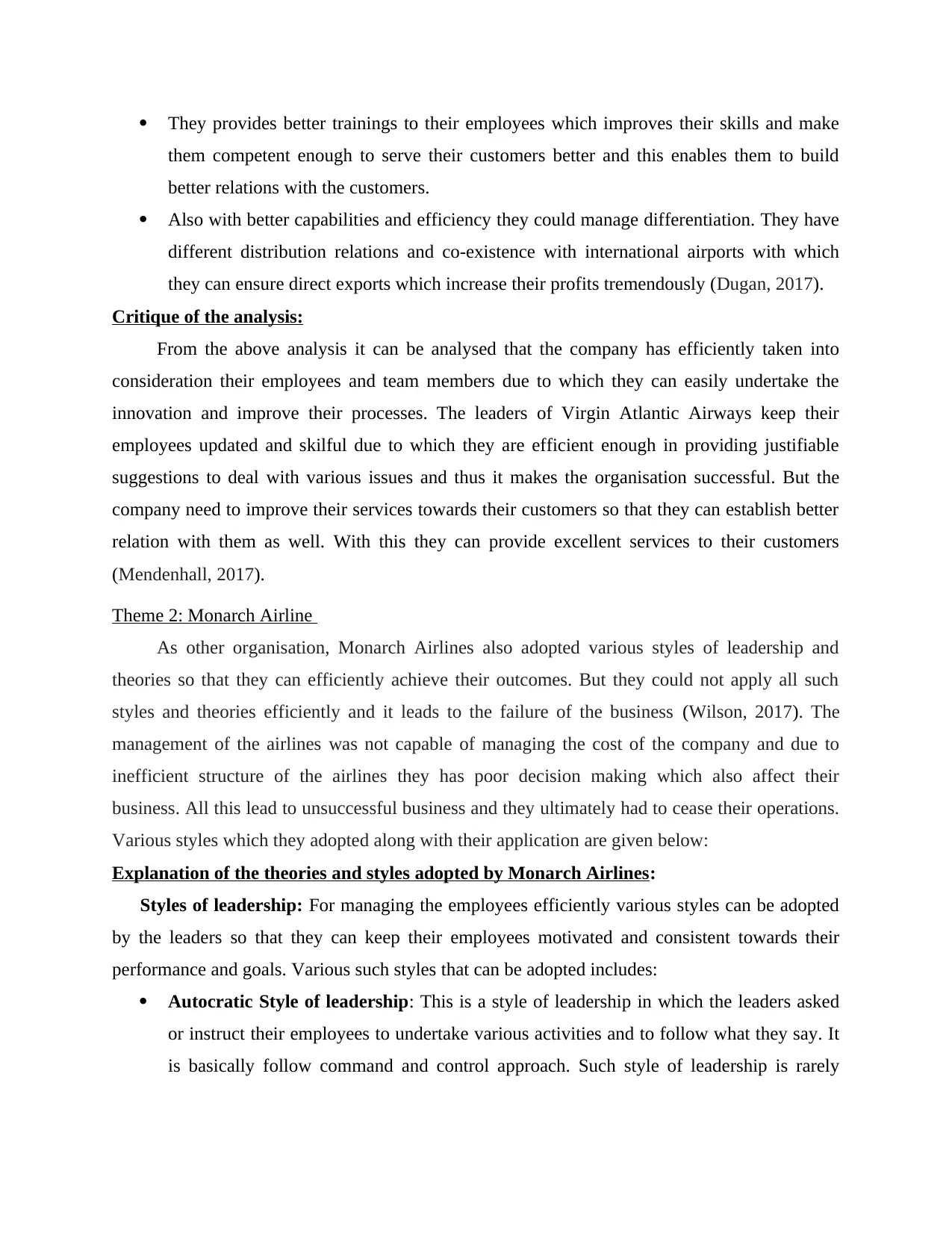
They provides better trainings to their employees which improves their skills and make
them competent enough to serve their customers better and this enables them to build
better relations with the customers.
Also with better capabilities and efficiency they could manage differentiation. They have
different distribution relations and co-existence with international airports with which
they can ensure direct exports which increase their profits tremendously (Dugan, 2017).
Critique of the analysis:
From the above analysis it can be analysed that the company has efficiently taken into
consideration their employees and team members due to which they can easily undertake the
innovation and improve their processes. The leaders of Virgin Atlantic Airways keep their
employees updated and skilful due to which they are efficient enough in providing justifiable
suggestions to deal with various issues and thus it makes the organisation successful. But the
company need to improve their services towards their customers so that they can establish better
relation with them as well. With this they can provide excellent services to their customers
(Mendenhall, 2017).
Theme 2: Monarch Airline
As other organisation, Monarch Airlines also adopted various styles of leadership and
theories so that they can efficiently achieve their outcomes. But they could not apply all such
styles and theories efficiently and it leads to the failure of the business (Wilson, 2017). The
management of the airlines was not capable of managing the cost of the company and due to
inefficient structure of the airlines they has poor decision making which also affect their
business. All this lead to unsuccessful business and they ultimately had to cease their operations.
Various styles which they adopted along with their application are given below:
Explanation of the theories and styles adopted by Monarch Airlines:
Styles of leadership: For managing the employees efficiently various styles can be adopted
by the leaders so that they can keep their employees motivated and consistent towards their
performance and goals. Various such styles that can be adopted includes:
Autocratic Style of leadership: This is a style of leadership in which the leaders asked
or instruct their employees to undertake various activities and to follow what they say. It
is basically follow command and control approach. Such style of leadership is rarely
them competent enough to serve their customers better and this enables them to build
better relations with the customers.
Also with better capabilities and efficiency they could manage differentiation. They have
different distribution relations and co-existence with international airports with which
they can ensure direct exports which increase their profits tremendously (Dugan, 2017).
Critique of the analysis:
From the above analysis it can be analysed that the company has efficiently taken into
consideration their employees and team members due to which they can easily undertake the
innovation and improve their processes. The leaders of Virgin Atlantic Airways keep their
employees updated and skilful due to which they are efficient enough in providing justifiable
suggestions to deal with various issues and thus it makes the organisation successful. But the
company need to improve their services towards their customers so that they can establish better
relation with them as well. With this they can provide excellent services to their customers
(Mendenhall, 2017).
Theme 2: Monarch Airline
As other organisation, Monarch Airlines also adopted various styles of leadership and
theories so that they can efficiently achieve their outcomes. But they could not apply all such
styles and theories efficiently and it leads to the failure of the business (Wilson, 2017). The
management of the airlines was not capable of managing the cost of the company and due to
inefficient structure of the airlines they has poor decision making which also affect their
business. All this lead to unsuccessful business and they ultimately had to cease their operations.
Various styles which they adopted along with their application are given below:
Explanation of the theories and styles adopted by Monarch Airlines:
Styles of leadership: For managing the employees efficiently various styles can be adopted
by the leaders so that they can keep their employees motivated and consistent towards their
performance and goals. Various such styles that can be adopted includes:
Autocratic Style of leadership: This is a style of leadership in which the leaders asked
or instruct their employees to undertake various activities and to follow what they say. It
is basically follow command and control approach. Such style of leadership is rarely
Paraphrase This Document
Need a fresh take? Get an instant paraphrase of this document with our AI Paraphraser
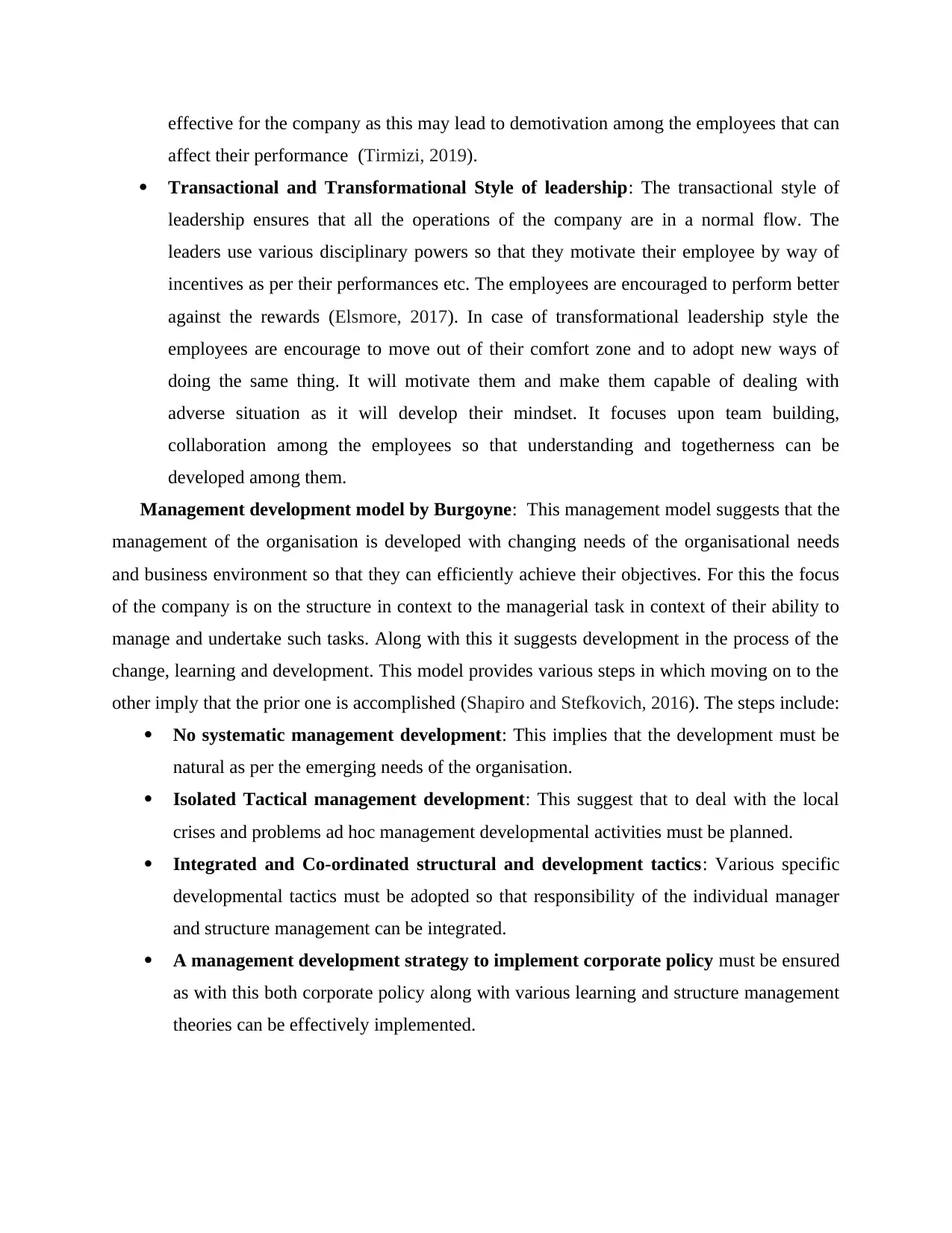
effective for the company as this may lead to demotivation among the employees that can
affect their performance (Tirmizi, 2019).
Transactional and Transformational Style of leadership: The transactional style of
leadership ensures that all the operations of the company are in a normal flow. The
leaders use various disciplinary powers so that they motivate their employee by way of
incentives as per their performances etc. The employees are encouraged to perform better
against the rewards (Elsmore, 2017). In case of transformational leadership style the
employees are encourage to move out of their comfort zone and to adopt new ways of
doing the same thing. It will motivate them and make them capable of dealing with
adverse situation as it will develop their mindset. It focuses upon team building,
collaboration among the employees so that understanding and togetherness can be
developed among them.
Management development model by Burgoyne: This management model suggests that the
management of the organisation is developed with changing needs of the organisational needs
and business environment so that they can efficiently achieve their objectives. For this the focus
of the company is on the structure in context to the managerial task in context of their ability to
manage and undertake such tasks. Along with this it suggests development in the process of the
change, learning and development. This model provides various steps in which moving on to the
other imply that the prior one is accomplished (Shapiro and Stefkovich, 2016). The steps include:
No systematic management development: This implies that the development must be
natural as per the emerging needs of the organisation.
Isolated Tactical management development: This suggest that to deal with the local
crises and problems ad hoc management developmental activities must be planned.
Integrated and Co-ordinated structural and development tactics: Various specific
developmental tactics must be adopted so that responsibility of the individual manager
and structure management can be integrated.
A management development strategy to implement corporate policy must be ensured
as with this both corporate policy along with various learning and structure management
theories can be effectively implemented.
affect their performance (Tirmizi, 2019).
Transactional and Transformational Style of leadership: The transactional style of
leadership ensures that all the operations of the company are in a normal flow. The
leaders use various disciplinary powers so that they motivate their employee by way of
incentives as per their performances etc. The employees are encouraged to perform better
against the rewards (Elsmore, 2017). In case of transformational leadership style the
employees are encourage to move out of their comfort zone and to adopt new ways of
doing the same thing. It will motivate them and make them capable of dealing with
adverse situation as it will develop their mindset. It focuses upon team building,
collaboration among the employees so that understanding and togetherness can be
developed among them.
Management development model by Burgoyne: This management model suggests that the
management of the organisation is developed with changing needs of the organisational needs
and business environment so that they can efficiently achieve their objectives. For this the focus
of the company is on the structure in context to the managerial task in context of their ability to
manage and undertake such tasks. Along with this it suggests development in the process of the
change, learning and development. This model provides various steps in which moving on to the
other imply that the prior one is accomplished (Shapiro and Stefkovich, 2016). The steps include:
No systematic management development: This implies that the development must be
natural as per the emerging needs of the organisation.
Isolated Tactical management development: This suggest that to deal with the local
crises and problems ad hoc management developmental activities must be planned.
Integrated and Co-ordinated structural and development tactics: Various specific
developmental tactics must be adopted so that responsibility of the individual manager
and structure management can be integrated.
A management development strategy to implement corporate policy must be ensured
as with this both corporate policy along with various learning and structure management
theories can be effectively implemented.
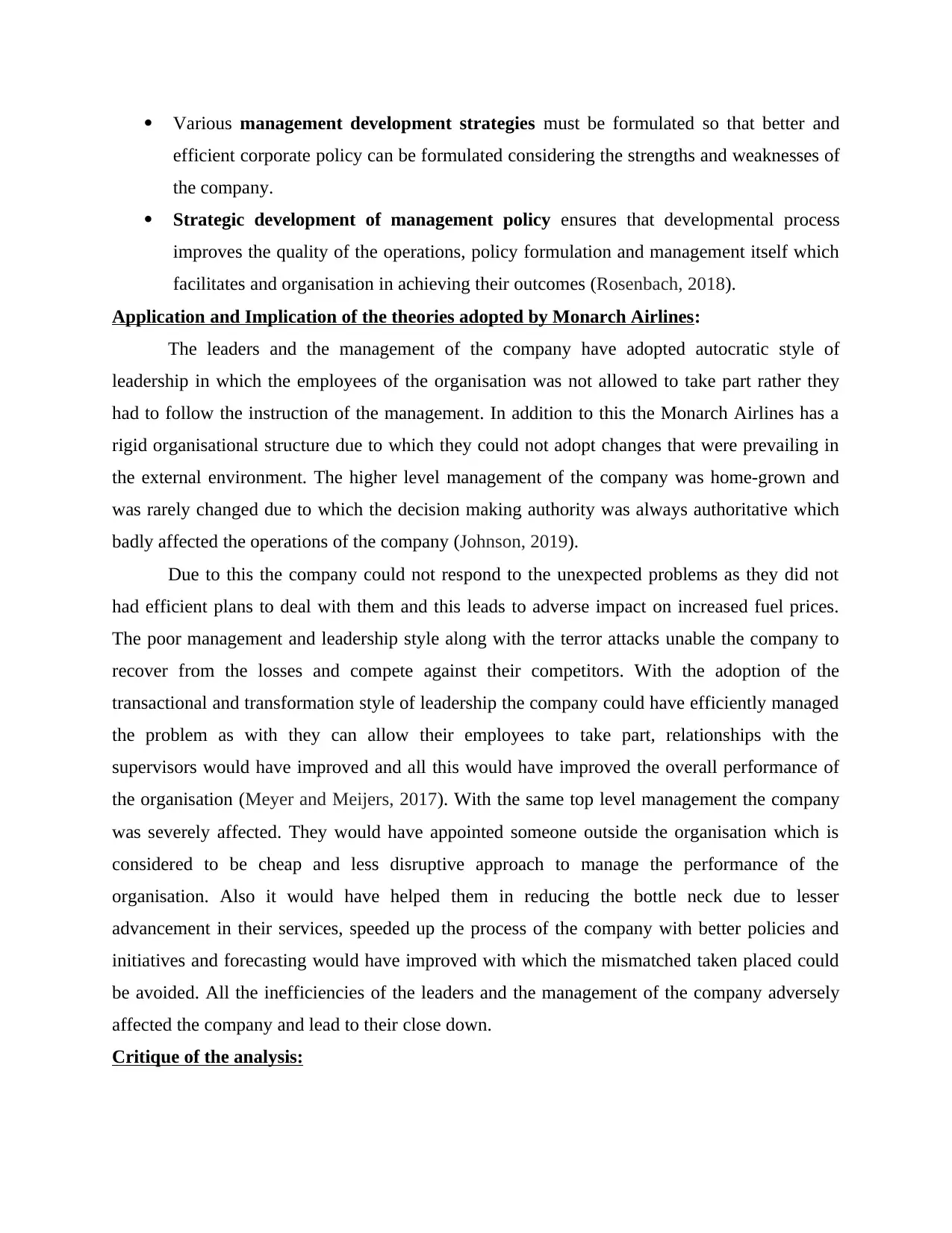
Various management development strategies must be formulated so that better and
efficient corporate policy can be formulated considering the strengths and weaknesses of
the company.
Strategic development of management policy ensures that developmental process
improves the quality of the operations, policy formulation and management itself which
facilitates and organisation in achieving their outcomes (Rosenbach, 2018).
Application and Implication of the theories adopted by Monarch Airlines:
The leaders and the management of the company have adopted autocratic style of
leadership in which the employees of the organisation was not allowed to take part rather they
had to follow the instruction of the management. In addition to this the Monarch Airlines has a
rigid organisational structure due to which they could not adopt changes that were prevailing in
the external environment. The higher level management of the company was home-grown and
was rarely changed due to which the decision making authority was always authoritative which
badly affected the operations of the company (Johnson, 2019).
Due to this the company could not respond to the unexpected problems as they did not
had efficient plans to deal with them and this leads to adverse impact on increased fuel prices.
The poor management and leadership style along with the terror attacks unable the company to
recover from the losses and compete against their competitors. With the adoption of the
transactional and transformation style of leadership the company could have efficiently managed
the problem as with they can allow their employees to take part, relationships with the
supervisors would have improved and all this would have improved the overall performance of
the organisation (Meyer and Meijers, 2017). With the same top level management the company
was severely affected. They would have appointed someone outside the organisation which is
considered to be cheap and less disruptive approach to manage the performance of the
organisation. Also it would have helped them in reducing the bottle neck due to lesser
advancement in their services, speeded up the process of the company with better policies and
initiatives and forecasting would have improved with which the mismatched taken placed could
be avoided. All the inefficiencies of the leaders and the management of the company adversely
affected the company and lead to their close down.
Critique of the analysis:
efficient corporate policy can be formulated considering the strengths and weaknesses of
the company.
Strategic development of management policy ensures that developmental process
improves the quality of the operations, policy formulation and management itself which
facilitates and organisation in achieving their outcomes (Rosenbach, 2018).
Application and Implication of the theories adopted by Monarch Airlines:
The leaders and the management of the company have adopted autocratic style of
leadership in which the employees of the organisation was not allowed to take part rather they
had to follow the instruction of the management. In addition to this the Monarch Airlines has a
rigid organisational structure due to which they could not adopt changes that were prevailing in
the external environment. The higher level management of the company was home-grown and
was rarely changed due to which the decision making authority was always authoritative which
badly affected the operations of the company (Johnson, 2019).
Due to this the company could not respond to the unexpected problems as they did not
had efficient plans to deal with them and this leads to adverse impact on increased fuel prices.
The poor management and leadership style along with the terror attacks unable the company to
recover from the losses and compete against their competitors. With the adoption of the
transactional and transformation style of leadership the company could have efficiently managed
the problem as with they can allow their employees to take part, relationships with the
supervisors would have improved and all this would have improved the overall performance of
the organisation (Meyer and Meijers, 2017). With the same top level management the company
was severely affected. They would have appointed someone outside the organisation which is
considered to be cheap and less disruptive approach to manage the performance of the
organisation. Also it would have helped them in reducing the bottle neck due to lesser
advancement in their services, speeded up the process of the company with better policies and
initiatives and forecasting would have improved with which the mismatched taken placed could
be avoided. All the inefficiencies of the leaders and the management of the company adversely
affected the company and lead to their close down.
Critique of the analysis:
⊘ This is a preview!⊘
Do you want full access?
Subscribe today to unlock all pages.

Trusted by 1+ million students worldwide
1 out of 16
Related Documents
Your All-in-One AI-Powered Toolkit for Academic Success.
+13062052269
info@desklib.com
Available 24*7 on WhatsApp / Email
![[object Object]](/_next/static/media/star-bottom.7253800d.svg)
Unlock your academic potential
Copyright © 2020–2025 A2Z Services. All Rights Reserved. Developed and managed by ZUCOL.




